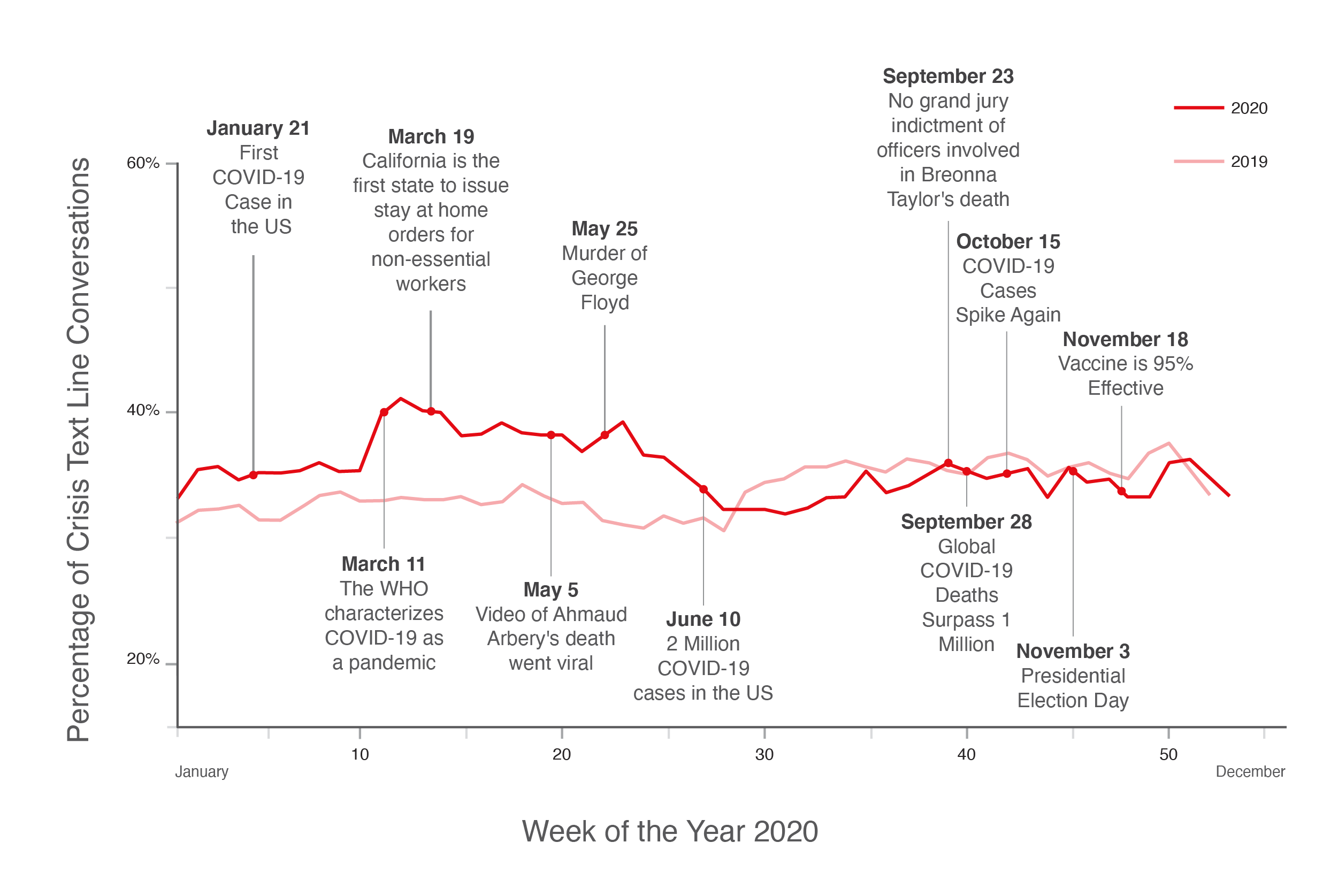Everybody Hurts 2020
Just after noon on Monday March 16, 2020, the light signaling the number of people waiting for a Crisis Text Line Crisis Counselor briefly flashed from green to yellow, and then turned red. A red queue indicated that there was more incoming volume from texters in crisis than current volunteers on the platform. By 2 pm, conversation volume was up by 29% from an average day of ~3,000 conversations, and by 7 pm, volume had doubled.
Crisis Text Line was experiencing an epic spike. Around the country, Crisis Text Line volunteers received a text message, asking if they could log-in and take a shift as a Crisis Counselor to support the rapidly growing number of people dealing with anxiety, fear, and panic. By midnight, Crisis Text Line had 5,900 conversations with people in crisis. The next day, volume was even higher at 6,606 conversations. More than half of the texters who reached out during those days contacted Crisis Text Line for the first time.
Most crisis lines respond to texters in the order in which they arrive in a queue. We act more like an emergency room, where a person with a gunshot wound gets help before a person with a broken leg. An algorithm runs in the background and assesses a texter’s suicidal risk based on their first few messages. We reach high-risk texters in about 8 seconds and aim to connect all texters with a Crisis Counselor in less than 5 minutes.
One week before, the World Health Organization declared COVID-19 a global pandemic. The mental health crisis was well underway and Crisis Text Line was ready (and already remote) to support people who were working on the frontlines as health care and essential workers, students who found their lives interrupted by quarentines, parents who were trying to hold it all together, and thousands of others who needed a stranger to listen to their pain. We had 1.4 million conversations with texters during 2020, with higher than average volume of ~3,000 conversations almost every day after March 16th.
 Percentage of Conversations About Anxiety as Marked by Crisis Counselors
Percentage of Conversations About Anxiety as Marked by Crisis Counselors
As the pandemic raged on, thousands of people found themselves quarantining at home, wanting to do something positive and productive. In March and April, more than 15,000 applied to become a Crisis Counselor. Soon, volunteer capacity outpaced texter demand.
During the summer, COVID-19 infection and death rates soared against the backdrop of an economic recession, massive protests in response to the murder of George Floyd, and a polarizing Presidential Election.
Racism creates trauma. Trauma is a devastating emotional response to brutally painful experiences that threaten safety. Prolonged exposure to systemic racism, whether through violent incidents or micro aggressions, contributes to chronic stress and other risk factors that worsen mental health. In April 2021, the Center for Disease Control (CDC) released a statement identifying racism as a public health threat.
Throughout the year, Crisis Text Line’s data science team was watching trends in real-time and wondering what the data would say about the emotionally overwhelming year. We wanted to understand how mental health issues like anxiety, depression, and suicide shifted in 1.4 million crisis conversations in 2020, and learn from the words associated with the COVID-19 crisis in the 48 million messages that were exchanged between texters and volunteers.

Percentage of Conversations About Depression as Marked by Crisis Counselors
Following our first state of mental health report released in February 2020, Crisis Text Line presents Everybody Hurts 2020: What 48 Million Messages Say About the State of Mental Health in America, which highlights what we learned about mental health during that difficult year through 1.4 million conversations nationally and in all 50 states, plus Washington D.C. and Puerto Rico. We are sharing this information to help you understand the crisis trends in your state, including the demographics of people who are reaching out to Crisis Text Line for support.
Download the report or read it online.
1 The onset of the COVID-19 pandemic in 2020 was not the first time, nor the last time that Crisis Text Line experienced a volume spike, and not all high volume days are associated with current events. Crisis Text Line had a 800% volume jump on the night of the 2016 elections. There were also three historically high volume days in late November 2020, when a few TikTok and Facebook messages about mental health went viral.

